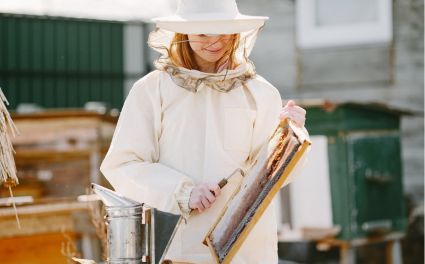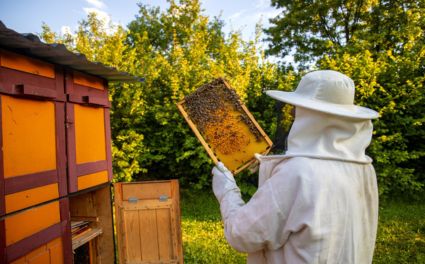Bee colonies are among nature’s most efficient communities — managing thousands of honey bees through perfect organization and communication. From the queen bee’s leadership to the worker bees’ cooperation, every member plays a vital role. Let’s explore how bee colonies function, survive through seasons, and how modern beekeeping equipment supports their well-being.
Structure of a Bee Colony
A bee colony has three main types of bees: the queen bee, worker bees, and drone bees — each with distinct roles ensuring the colony’s survival.
Queen Bee – The Heart of the Hive
The queen bee is the center of the colony’s life. She lays up to 2,000 eggs daily during peak season. Her pheromones keep the hive united and organized.
Queens are larger than workers, with long abdomens and smooth stingers. While she rarely leaves the hive, her single mating flight provides enough sperm for a lifetime of egg-laying.
Worker Bees – The Hive’s True Heroes
Worker bees, all female, form the backbone of the colony. Their responsibilities evolve with age — from nursing young larvae to guarding the entrance and foraging nectar.
In summer, they live only a few weeks due to intense labor, but winter workers can survive for months. Their diligence ensures constant food flow and brood care.
To safely inspect and manage hives, beekeepers use protective clothing such as
These ensure protection from stings while maintaining comfort and breathability.
Drone Bees – Nature’s Gentlemen
Drone bees are the males of the hive. Their only purpose is to mate with virgin queens from other colonies. Drones lack stingers and do not gather nectar or defend the hive.
As winter nears, worker bees push drones out to conserve resources — a remarkable example of the colony’s instinct for survival.

Hive Organization and Structure
Inside a hive, every hexagonal cell, every layer of wax, and every buzzing sound has meaning.
Brood Chambers and Honey Supers
The brood chamber houses eggs, larvae, and pupae — the next generation of bees. Worker bees maintain warmth by fanning wings and clustering.
Above it lie the honey supers, where nectar is stored and transformed into honey. Beekeepers harvest honey from these supers without disturbing the brood.
Quality gear like Beekeeping Trousers and ankle protection from trusted brands like OZ Armour keeps them safe during harvesting.
Storage and Temperature Control
Bees use wax combs to store honey, pollen, and nectar. The wax also helps insulate the hive.
Worker bees fan their wings to reduce heat or cluster to generate warmth — maintaining the perfect temperature for developing brood.
🐝 Fun fact: Bees maintain their hive between 33–36 °C — just right for their young to thrive.
Communication and Cooperation
Bees are masters of teamwork. Their survival depends on flawless communication.
The Language of Bees
Bees communicate through pheromones and dances. Queen pheromones keep harmony, while worker bees release scents signaling alarm or food discovery.
The famous waggle dance tells other foragers the distance and direction of nectar. Such coordination amazes scientists studying the Lives of Bees and inspires technologies in collective decision-making.
Also read: The Secret Lives of Bees – How Long Do They Really Live?
Division of Labor
Younger worker bees care for the brood; older ones venture outside. This age-based specialization keeps the colony efficient — a biological version of a perfectly run company.
Collective Decision-Making
When it’s time to swarm or find a new home, bees debate through dances! Worker scouts explore new sites and “vote” using waggle intensity until a consensus is reached.
This process shows nature’s democracy — no single ruler decides everything, not even the queen.
Seasonal Patterns in Bee Colonies
Spring Buildup
Spring begins with rebirth. The queen resumes heavy egg-laying, and foragers bring nectar from blooming flowers.
Beekeepers must ensure food supply and space, wearing beekeeping suits and kids’ bee suits when involving families in apiary learning.
👨👩👧👦 Tip: Pink Bee Suits are popular among new beekeepers — offering both safety and style!
Summer – Honey Production Peak
During summer, bees convert nectar into golden honey. Colonies are most active, and hives buzz with productivity.
Beekeepers collect honey wearing full-body protection to avoid stings — especially important when wasps are nearby. Many often wonder, “Do bee suits protect from wasps?” Yes, high-quality beekeeping jackets and veils provide reliable defense even in wasp-prone areas.
Learn more: Stinging Truth – Evaluating the Effectiveness of Bee Suits in Wasp Defense
Fall and Winter Survival
As nectar becomes scarce, colonies prepare for winter. Drones are expelled, and the population reduces to conserve energy. Worker bees cluster around the queen to generate heat.
Beekeepers ensure there’s enough honey stored and provide insulation using tools from reliable beekeeping equipment collections —
like Beekeeping Tools & Accessories and Beekeeping Equipments USA.
Good insulation and regular hive checks help the colony survive until spring.
Bee Behavior and Learning for Beekeepers
Understanding bee behavior helps both beginners and experienced beekeepers manage their colonies confidently.
Educational resources like Learn Beekeeping teach beginners about hive management, swarm control, and honey extraction.
For those fascinated by bee biology, here are more helpful reads:
Each helps expand knowledge and improve hive safety for both humans and honey bees.
Beekeeping Safety and Apparel
Safe beekeeping depends on proper gear. From veils that prevent facial stings to ankle protection, every piece matters.
Trusted global brands like OZ Armour design breathable beekeeping jackets and durable beekeeping gloves crafted to keep both professionals and beginners safe.
Whether managing hives in the UK countryside or tending bees in the USA, investing in reliable protection ensures confident handling and smoother inspections.
Explore more: Beekeeping Ankle Protection
Bee Knowledge Beyond the Hive
Beekeeping goes beyond harvesting honey — it’s about understanding nature’s harmony.
From recognizing a bee nest to distinguishing between a beehive and wasp nest, or even between bumblebee vs carpenter bees, each insight builds respect for these pollinators.
Discover more educational stories: Read More Blogs About Beekeeping
Final Thoughts
Bee colonies embody perfect teamwork — every role, from the queen to the youngest worker, supports survival. Their communication, cooperation, and adaptability make them one of nature’s greatest marvels.
For beekeepers, understanding these dynamics and using proper beekeeping suits, veils, gloves, and trousers ensures not just safety but a deeper connection with the Lives of Bees.
Whether you’re learning how to manage a hive or exploring how honey bees thrive, remember: behind every drop of honey lies a world of intelligence, organization, and unity.




